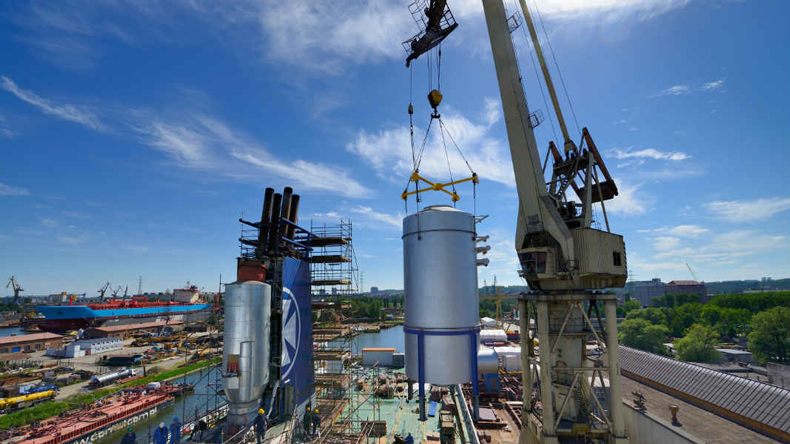



Owners are taking the opportunity to catch up with maintenance and scrubber retrofits

MORE SHIPS ARE HEADING TO YARDS FOR SCRUBBER RETROFITS TO REDUCE FUEL COSTS.
EASING port congestion and an increase in the number of new vessels being delivered has brought the active containership fleet back to more than 17m teu for the first time in a year, even as a larger number of ships go into lay-up for scrubber retrofits or maintenance.
Figures from Linerlytica show that the quantity of idle ships is increasing again, after a long period with virtually all available tonnage being employed.
“More ships have also entered drydock including ships undergoing scrubber retrofits,” it said. “Further increases are forthcoming, with new deliveries picking up pace while port congestion continues to ease over the coming three months.”
The consultancy firm recorded 42 ships comprising 121,031 teu without employment this week, with 25 waiting for deployment or open for spot charters.
“An increasing number of ships expected to be redelivered without new employment over the coming four weeks,” it said. “This will put further pressure on charter rates with no demand catalyst to trigger any rebound in the near term.”
Charter rates and periods had continued to fall in the past week, with charterers finally having the upper hand with the pool of spot vessels climbing rapidly. “Flexible charter periods of three to six months have become the norm even as rates continued to set new benchmark lows.”
But owners were also taking advantage of the lull in demand to send ships for maintenance or for scrubber retrofits, with 28 vessels, constituting 250,667 teu undergoing retrofits.
“After a two-year hiatus, more ships of below 5,000 teu are now being sent for scrubber retrofits as the continued high premium of low-sulphur fuel oil over heavy fuel oil have made scrubber installation attractive even for smaller ships,” Linerlytica said.
Hapag-Lloyd chief executive Rolf Habben Jansen noted that there would be a surge of demand for drydocking when cargo demand eased.
“The idle fleet, which is a good proxy for ships that are not sailing and that are in drydock or being repaired, has been at record low levels for the past 12 months,” he said in February. “We are not putting ships into their regular drydock, or not repairing ships, to ensure that they remain in service. That will mean that some more ships will need to go into drydock in 2023 and 2024.”
Since then, however, there has been a reduction in the number of ships tied up by congestion.
Linerlytica said port congestion had eased to a 10-month low, with even US east coast congestion coming off its recent peaks on the back of weaker cargo volumes.
“The situation will continue to improve as carriers adjust their capacity deployed on the transpacific routes over the next two months,” it said.
That capacity deployment, however, will mean fewer ships being utilised, which threatens to push up the number of idle ships further.
There are already fears that overcapacity may emerge again in the container sector after a huge order spree by carriers over the past two years that has taken the orderbook to 7.4m teu.
The “rapidly deteriorating” supply-demand outlook did not stop carriers from pushing ahead with capacity expansion plans, with Maersk and Mediterranean Shipping Co both confirming further orders for new tonnage last week. MSC alone has nearly 2m teu on order, according to Linerlytica, equivalent to 43% of its existing fleet.